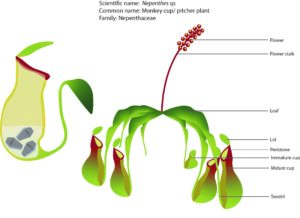
Pitcher plants – the “reed pipe” in nature
Background Pitcher plants are scattered around the world. Apart from Nepenthes and Darlingtonia, there are two more pitchers with different genus that are generally known as the American pitcher plants. Namely, Sarracenia and Heliamphora that both under the family of Sarraceniaceae. They are referred to as passive carnivores in which they use a passive preying mechanism that solely relies on the nectar and color or pigmentation of the modified leaves without any structural movements of […]
Read More
Darlingtonia, the cobra in carnivorous plants
Background Darlingtonia is commonly known as cobra lily due to its startling and special morphological structures. It is dicots, asterids, and found under the family of Sarraceniaceae. Obviously, Darlingtonia is very closely related to Sarracenia which is an allied genus known as trumpet pitchers that is indigenous to the eastern coast of the USA. It is so special with its bulbous green or red heads with a twisted colorful tongue that looks exactly like a cobra. […]
Read More
Carnivorous plants that look like Drosera
Well, we heard of sundew, the Drosera, when the dew is shined by light, it produces a mini rainbow. Why does it not called a rainbow plant? This is because the rainbow plant, the common name, is taken by Byblis under the family of Byblidaceae that is native to Australia. Byblis can appear as frosted sprays of water and sparkle with multicolored hues in the presence of light. It is not a sundew but it […]
Read More
Drosera, not the morning dew but sundew
Sundews (Drosera sp.) are probably the most diverse genus of carnivorous plants in the world which consisting of around two hundred species. Commonly known as sundew because the word, Drosera in Greek means dewy. The “dew” found on the hair of sundew exhibit mini-rainbows whenever they are struck by sunlight. They can be found in Canada, Alaska, Siberia, Europe, Nother America, Brazil, Queensland, southernmost regions of New Zealand, and South America. It occurs on almost […]
Read More
Pinguicula – the flypaper
Pinguicula sp. under the family of Lentibulariaceae, commonly known as butterwort, and means the little greasy one in Latin. It consists of about 50 species. It is greasy due to the slimy, sticky, and greasy touch of the leaves. “Ping” is not sticking to the common impression of carnivorous plants. They do not have the capability of killing large insects or small mammals with specialized and colorful leaves that differentiated into sophisticated traps. Pinguicula is […]
Read More
Nepenthes – not your “cup” of tea
If you think about a cup in nature, what comes to your mind? The monkey cup is a good call, as a carnivorous plant, scientifically referred to as Nepenthes sp., it is unique because of its modified cup-shaped leaf that looks like a small vase with a lid. Some people use the cup as a container to cook sticky rice added with coconut. Travelers often use older pitchers as water scoops or to catch rainwater. […]
Read More